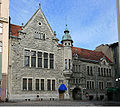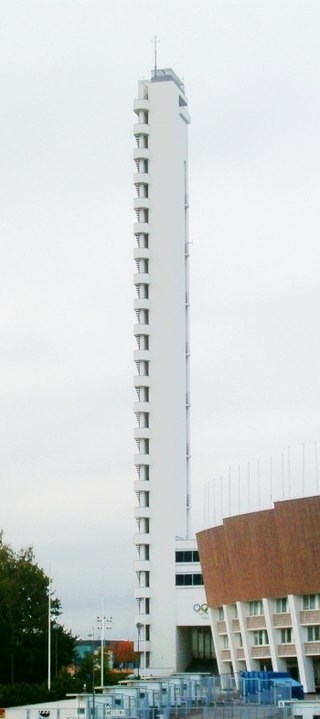
In architecture, functionalism is the principle that buildings should be designed based solely on their purpose and function. An international functionalist architecture movement emerged in the wake of World War I, as part of the wave of Modernism. Its ideas were largely inspired by a desire to build a new and better world for the people, as broadly and strongly expressed by the social and political movements of Europe after the extremely devastating world war. In this respect, functionalist architecture is often linked with the ideas of socialism and modern humanism.

Vålerenga Church is a church located in Oslo, Norway. Vålerenga church stands in the middle of Vålerenga park in the neighborhood of Vålerenga. The church belongs to the parish of Vålerenga of the Oslo arch-deanery within the Diocese of Oslo of the Church of Norway.

The Baroque Revival, also known as Neo-Baroque, was an architectural style of the late 19th and early 20th centuries. The term is used to describe architecture and architectural sculptures which display important aspects of Baroque style, but are not of the original Baroque period. Elements of the Baroque architectural tradition were an essential part of the curriculum of the École des Beaux-Arts in Paris, the pre-eminent school of architecture in the second half of the 19th century, and are integral to the Beaux-Arts architecture it engendered both in France and abroad. An ebullient sense of European imperialism encouraged an official architecture to reflect it in Britain and France, and in Germany and Italy the Baroque Revival expressed pride in the new power of the unified state.
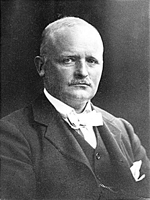
Hack Kampmann was a Danish architect, Royal Inspector of Listed State Buildings in Jutland and professor at the architecture department of the Royal Danish Academy of Fine Arts. Marselisborg Palace in Aarhus, built between 1899 and 1902, is among his best known works.
This article covers the architecture of Sweden from a historical perspective.
The European Amateur Boxing Championships is the highest competition for boxing amateurs in Europe, organised by the continent's governing body EUBC, which stands for the European Boxing Confederation. The first edition of the tournament took place in 1924, although the first 'competitive' championships were hosted by the city of Stockholm (Sweden) in 1925.

Nordic Classicism was a style of architecture that briefly blossomed in the Nordic countries between 1910 and 1930.
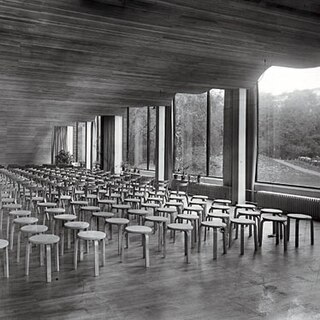
The architecture of Finland has a history spanning over 800 years, and while up until the modern era the architecture was highly influenced by Sweden, there were also influences from Germany and Russia. From the early 19th century onwards influences came directly from further afield: first when itinerant foreign architects took up positions in the country and then when the Finnish architect profession became established.
The 1933–36 Nordic Football Championship was the third Nordic Football Championship staged. Four Nordic countries participated, Denmark, Finland, Norway and Sweden. The tournament was arranged by the Football Association of Norway. The trophy was named the Nordiske Pokal. A total of 24 matches were played with 104 goals scored giving an average of 4.33 goals per match.
The 1937–47 Nordic Football Championship was the fourth Nordic Football Championship staged. Four Nordic countries participated, Denmark, Finland, Norway and Sweden. The tournament was arranged by the Football Association of Finland. The trophy was named Suomen Karhut. The tournament which was originally supposed to end in 1940, but the Second World War interrupted it and the last six matches were not played until 1947.

The architecture of Denmark has its origins in the Viking Age, richly revealed by archaeological finds. It became firmly established in the Middle Ages when first Romanesque, then Gothic churches and cathedrals sprang up throughout the country. It was during this period that, in a country with little access to stone, brick became the construction material of choice, not just for churches but also for fortifications and castles.

Foreningen Norden, Föreningen Norden (Swedish), Norræna félagið (Icelandic), Norrøna Felagið (Faroese), Peqatigiiffik Nunat Avannarliit (Greenlandic) and Pohjola-Norden (Finnish), The Norden Associations, sometimes referred to as The Nordic Associations are non-governmental organisations in the Nordic countries promoting civil cooperation between the Nordic countries. Established since 1919, there are Norden Associations in Sweden, Norway, Denmark, Finland, Iceland, Greenland, the Faroe Islands and Åland. Since 1965 these national branches are grouped in an umbrella organisation Foreningene Nordens Forbund (FNF), The Confederation of Norden Associations. The co-operation between the Nordic countries include projects such as Nordjobb, Nordic Library Week and Norden at the Cinema.
Kaljo Põllu was an Estonian artist. In 1962 he received a diploma in glass art, and became director of art cabinet of Tartu State University; he founded the contemporary artist's group Visarid in 1966 in Tartu. In 1973 he moved to Tallinn, where from 1975 to 1996 he taught drawing in the Estonian Academy of Arts; at this point his art changed in style dramatically as he searched for influences from the ancient Finno-Ugric culture.
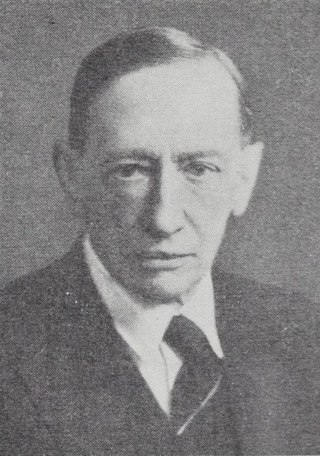
Harald Aars was a Norwegian architect.

Arkitema Architects is a Danish architectural firm headquartered in Aarhus, with branch offices in Copenhagen, Malmö, Stockholm and Oslo. Arkitema Architects was founded in 1969 in Aarhus, and nowadays has about 400 employees with its main activity in Scandinavia.

Hans Vilhelm Ahlmann was a Swedish and Danish architect. He is credited with designing and restoring a variety of churches in Denmark.

Holdre is a village in Tõrva Parish, Valga County in Estonia.

Aarhus Old City Hall is the former city hall of Aarhus, Denmark, and a listed building. The city hall was built in 1857 and was listed in the Danish national registry of protected buildings and places by the Danish Heritage Agency on 18 March 1996. It is the second, and oldest preserved, city hall of Aarhus.

The architecture of Aarhus comprises numerous architectural styles and works from the Middle Ages to present-day. Aarhus has a well-preserved medieval city center with the oldest dwellings dating back to the mid-1500s and some ecclesiastical structures such as St. Clemen's Cathedral and numerous smaller churches that can be traced back to the 1100s. The industrialization of the 19th and 20th centuries left distinctive industrial structures, important National romantic works and some of the best examples of Functionalist architecture in the country. The history of the city as a Viking fort is evidenced in the street layout of the Latin Quarter, the wider Indre By neighborhood testifies to its later role as a Market town and center of commerce while the Frederiksbjerg, Trøjborg and Marselisborg districts showcase the first cohesive urban planning efforts of the early 20th century.

The Pohjola Insurance building is the former headquarters of the Pohjola Insurance Company at Aleksanterinkatu 44 and Mikonkatu 3 in central Helsinki. Primarily designed by Gesellius, Lindgren & Saarinen and constructed in 1899–1901, it is a prominent example of Finnish national romantic architecture. It was acquired in 1972 by Kansallis-Osake-Pankki, now succeeded by Nordea.






